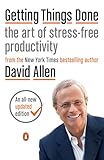Getting things done
how igor ticksGetting Things Done (GTD) is a model based on David Allen’s book of the same name. It’s a deep dive into Habit 3 - first things first, with some lite weight Habit 2 - begin with the end in mind, mixed in for good measure. By using GTD religiously you can have a drastic reduction in stress and procrastination.
Theory
Open loops and Psychic Weight
Open loops are caused by your brain continuing to think of an open issue when you don’t want it to. Open loops are psychic weight and are a great source of anxiety. By getting your open-loops capture into a system your brain trusts, your brain can stop thinking about this.
Activation Energy and Procrastination
Thinking vs Doing Next Actions
It’s easy to procrastinate when the next action isn’t clear
Practices
Capture
Your brain is terrible at remembering stuff, often forgetting the important, and dwelling on the un-actionable. As soon as a thought/task comes in, add it to your inbox
Triage - Drop; Do; Delegate; Defer
All incoming tasks should handled by one of the four workflows and ignored from that point forward:
- Drop - Best case :) See Essentialism and the dip
- Do - If it takes less than 2 minutes, get it done. Otherwise the overhead is too high.
- Delegate - Get someone else to do it, outsourcing is great.
- Defer - Convert it into a “next action”, words you’ll understand later context free, and add it to a project
Power Hour - Grind
When you get a reasonable chunk of time, crack open a project, and grind through the next actions.
Weekly Review
To make sure your brain trusts the system, and doesn’t recreate open loops, it needs to know what’s in your system will be good and not lost. Use a weekly review to go through your projects and see if anything needs to be done urgently.
Software
Here’s some software that I’ve used. None is perfect for me (I’m not sure what would be perfect), which is a shame. I think the best advice I have is, it doesn’t matter what you use, it matters that you use it. I’ll tell you when I find my perfect system.
OmniFocus
Primarily Apple, and incredibly complicated (aka powerful). The complexity is easy to get lost in, but really nice UX, and lots of good features. It has a web interface, but it’s amazing on the mac, less so on Windows.
Nozbe
Multiplatform was best in class in 2012 when it was created, but hasn’t had many upgrades since. I used it for years.
Flow
Flow is a minimalist focus timer that helps enforce timeboxing and single-tasking. It provides two key values:
Obvious:
- You force yourself to not get distracted by working on other stuff - by naming your current task, you stay focused on one thing
- You force yourself to work the minimum time before stopping
Non-obvious:
- You force yourself to notice how long you are spending (which can be a long time when sucked into flow, both on things I’m doing chop, but also on pointless tasks like re-writing a paragraph over and over)
- You force yourself to decide what you are working on, causing prioritization
Cool Features:
- Stays synchronized between watch, phone and desktop
- Writes flows to your calendar for future tracking
Cool Features I’ve Added:

